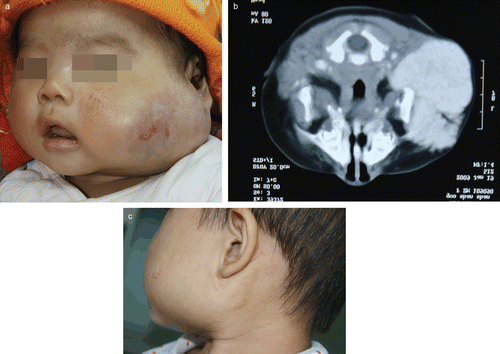Abstract
A brief comment on efficacy and safety of propranolol in the treatment of parotid hemangioma is presented, with illustration of a typical case.
Keywords::
Dear Editor:
I read the article entitled “Efficacy and safety of propranolol in the treatment of parotid hemangioma (Citation1)” published in Cutan Ocul Toxicol 2011 Feb 21 with great interest. I totally agree with the authors’ conclusion: propranolol is an effective, safe, and well-tolerated treatment for parotid hemangioma. In fact, since first reported in June 2008 (Citation2), propranolol has been widely used as a first-line therapy for various types of infantile hemangioma (IH) (rapidly proliferating, involuting, beyond the proliferation phase, ulcerated, etc (Citation3–6)) and IH in various primary sites, such as periocular (Citation7), orbital (Citation8), subglottic (Citation9), airway (Citation10), etc. It has been proved to be an extremely effective treatment option for IH and has little side effects. Minor side effects, expected from beta-blocker therapy, such as agitated sleep (Citation11), diarrhea (Citation12) and hypoglycemia (Citation13) are common but easily managed.
We have been using propranolol for treatment of head and neck IHs since 2008, up to now, more than 300 children with IH were treated in our department with excellent cosmetic and functional results. Among them, thirty five were parotid hemangioma. Contrary to most reports, the dose of propranolol we used is 1.0–1.5 mg/kg (with 1.0 mg/kg for children below 2.5-month-old and 1.5 mg/kg for those above 2.5-month-old), and the drug was taken once daily rather than twice a day without increase or taper during the treatment course (Citation14). The pre-treatment measures include EKG, echocardiogram and routine blood test. If the examinations were within normal, oral propranolol was initiated. The mean age of symptom onset was 20 days. The mean age for starting propranolol treatment was 2.5 months, and in all cases, a clinical response was observed within 7 days. Twenty eight patients had complete resolution 3–9 months after starting medication without any sequelae. Seven patients responded well but with some post-involution changes, such as telangiectasia and residual fibrofatty tissues. No serious side-effect was encountered. We believe that oral propranolol 1.0–1.5° mg/kg/day was a well-tolerated and effective treatment for head and neck IHs and should be used as the treatment of choice for hemangiomas that cause complications. Further studies are required to determine the appropriate protocol and duration of treatment for problematic hemangiomas.
A typical case with parotid hemangioma treated with oral propranolol is illustrated in .
Figure 1. A girl born in November 18, 2008 with huge hemangioma in the left parotid gland was treated with oral propranolol at a dose of 1.5 mg/kg/day. (A) Before treatment at the age of 3.5 months. (B) MRI showed a large mass with high signal intensity in the left parotid gland. (C) Lateral view at the age of 22 months, the tumor completely disappeared after oral propranolol treatment for 7 months.

Declaration of interest
The authors report no conflicts of interest.
References
- Morais P, Magina S, Mateus M, Trindade E, Jesus JM, Azevedo F. Efficacy and safety of propranolol in the treatment of parotid hemangioma. Cutan Ocul Toxicol 2011.
- Léauté-Labrèze C, Dumas de la Roque E, Hubiche T, Boralevi F, Thambo JB, Taïeb A. Propranolol for severe hemangiomas of infancy. N Engl J Med 2008;358:2649–2651.
- Holmes WJ, Mishra A, Gorst C, Liew SH. Propranolol as first-line treatment for rapidly proliferating infantile haemangiomas. J Plast Reconstr Aesthet Surg 2011;64:445–451.
- Buckmiller LM, Munson PD, Dyamenahalli U, Dai Y, Richter GT. Propranolol for infantile hemangiomas: Early experience at a tertiary vascular anomalies center. Laryngoscope 2010;120:676–681.
- Zvulunov A, McCuaig C, Frieden IJ, Mancini AJ, Puttgen KB, Dohil M et al. Oral propranolol therapy for infantile hemangiomas beyond the proliferation phase: A multicenter retrospective study. Pediatr Dermatol 2011;28:94–98.
- Naouri M, Schill T, Maruani A, Bross F, Lorette G, Rossler J. Successful treatment of ulcerated haemangioma with propranolol. J Eur Acad Dermatol Venereol 2010;24:1109–1112.
- Missoi TG, Lueder GT, Gilbertson K, Bayliss SJ. Oral propranolol for treatment of periocular infantile hemangiomas. Arch Ophthalmol 2011.
- Fridman G, Grieser E, Hill R, Khuddus N, Bersani T, Slonim C. Propranolol for the treatment of orbital infantile hemangiomas. Ophthal Plast Reconstr Surg 2011.
- Guye E, Chollet-Rivier M, Schröder D, Sandu K, Hohlfeld J, de Buys Roessingh A. Propranolol treatment for subglottic haemangioma. Arch Dis Child Fetal Neonatal Ed 2011.
- Peridis S, Pilgrim G, Athanasopoulos I, Parpounas K. A meta-analysis on the effectiveness of propranolol for the treatment of infantile airway haemangiomas. Int J Pediatr Otorhinolaryngol 2011;75:455–460.
- Bagazgoitia L, Torrelo A, Gutiérrez JC, Hernández-Martín A, Luna P, Gutiérrez M et al. Propranolol for infantile hemangiomas. Pediatr Dermatol 2011;28:108–114.
- Abbott J, Parulekar M, Shahidullah H, Taibjee S, Moss C. Diarrhea associated with propranolol treatment for hemangioma of infancy (HOI). Pediatr Dermatol 2010;27:558.
- Holland KE, Frieden IJ, Frommelt PC, Mancini AJ, Wyatt D, Drolet BA. Hypoglycemia in children taking propranolol for the treatment of infantile hemangioma. Arch Dermatol 2010;146:775–778.
- Zheng JW. Invited commentary. J Plast Reconstr Aesthet Surg 2011;64:299–300.